Mike Shifferd, Wayne Westgaard, & Doug Spears - Twenty years of TAMKO Six Sigma Excellence - PODCAST TRANSCRIPTION
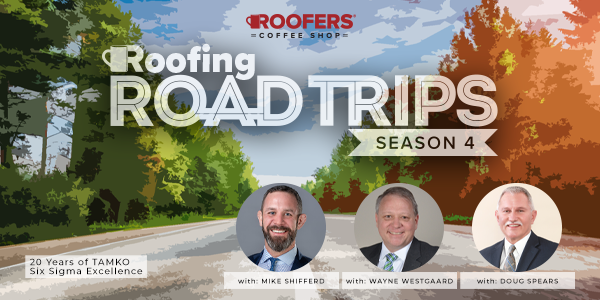
Editor's note: The following is the transcript of a live interview with Mike Shifferd, Wayne Westgaard and Doug Spears of TAMKO. You can read the interview below or listen to the podcast.
Speaker 1:
Welcome to Roofing Road Trips with Heidi. Explore the roofing industry through the eyes of a long-term professional within the trade. Listen for insights, interviews and exciting news in the roofing industry today.
Heidi Ellsworth:
Hello and welcome to another Roofing Road Trips from RoofersCoffeeShop. My name is Heidi Ellsworth, and today's podcast we're road tripping cross country to visit with some pioneers, some people who have made things happen in the roofing industry who don't always get credit for it, and I want to talk about it because I'm really excited.
Heidi Ellsworth:
Today, we're here with Mike Shifferd, Wayne Westgaard and Doug Spears of TAMKO. Yes, TAMKO, we are talking about innovation like nobody's business, and we're actually going to road trip back about 20 years to where it all started. Before we do get there though, I want to start with all of our special guests and have them introduce themselves so you can see how great they are.
Heidi Ellsworth:
Wayne, let's start with you. Please introduce yourself, and welcome to the show.
Wayne Westgaard:
Yeah. Thank you very much, Heidi. I'm Wayne Westgaard. I live in Dallas, Texas. I work with TAMKO for 20 years this June 10th, and I've worked in several different manufacturing plants in TAMKO. I was a general manager, ran several plants. I ran our Phillipsburg, Kansas, plant, our Dallas plant, and we used to have a plant in Ennis, Texas, for commercial roofing. Yeah, I really enjoyed working for TAMKO. I work in lots of different areas. I started out in Six Sigma with TAMKO, and that's what we're talking about today. Actually, Doug Spears hired me, so I think this is really interesting to have us here on this call today. I'd like to know a little bit more about Doug before I knew him.
Heidi Ellsworth:
I love it. I love it. Well, Doug, welcome to the show, and tell us about yourself.
Doug Spears:
Thank you. Again, I am Doug Spears, and I have been with TAMKO for 23 years. I actually started out in training, training and development, and then went into plant management at our composite decking plant, came back, and that's when I started, got involved with Six Sigma. I got involved with that and the deployment of that, and then went to recruiting and went into HR, and now I'm in talent development, so done a lot of different things at TAMKO and, truly, I'm just living the dream, yeah, absolutely.
Heidi Ellsworth:
Wow. I love it. Congratulations. 20 years, we're going to talk a lot more about that here, but first, Mike, welcome to the show, and please tell us about yourself.
Mike Shifferd:
Hi. Thanks a lot, Heidi. I am the current director of Six Sigma here at TAMKO. I've held this role since about 2017, so about five years now. I started in TAMKO about 18 years ago, so back in 2004. About two years after we started the Six Sigma journey, I would say, I also was hired by Mr. Doug Spears. There's something good about that common ground, but, yeah, I started as a Six Sigma Black Belt back in 2004, and I've held a number of various positions around TAMKO since then after joining TAMKO out of the military, out of the US Army back in 2004.
Heidi Ellsworth:
Wonderful. Well, as always, thank you for your service. We always have to say that because-
Mike Shifferd:
Thank you.
Heidi Ellsworth:
Yeah. This podcast is all about Six Sigma and TAMKO's 20th anniversary of having Six Sigma, which I just think is incredible. I really am excited to hear all about this, so I think we should start at the beginning. Doug, since you hired everybody, maybe we should have you start at the beginning on how did Six Sigma get started at TAMKO?
Doug Spears:
Well, I think the best place to start is even before Six Sigma back in 1980 when TAMKO adopted the Deming philosophies. One of the things about Six Sigma and one of the things in the decision to go with the Six Sigma to deploy at TAMKO was the idea that aligned directly with Deming, so we work that constancy of purpose. We are continuing on with the same thought, same mind frame, just moving it forward.
Doug Spears:
Back in 19... or back in... when we started Six Sigma. We had a group of three executives that went to a local plant that had already deployed Six Sigma to see how it affected them. They got to go on a visit. They got to go through the operations and really talk to some of their counterparts about the impact that Six Sigma had had on their organization. After going, they decided, wow, this is something that we need. This will work well for us, fit into our culture, so we decided to deploy Six Sigma.
Doug Spears:
The decision was made again after a lot of thought. It began like that, keeping the continuity of who we are and also, again, moving that forward to the next step, becoming a... that next step. We move from Deming with a lot of incremental improvements to Six Sigma with these breakthrough improvements, so, again, augmenting where we were. That's when a lot of the work started. T.
Doug Spears:
He first thing we did was, well, hire a consultant to help us a little bit with the deployment, but also we got a lot of training to do, so we needed someone to help us with that Six Sigma training because we were new to the field, new to the playing field. We did that, and then we started to develop the philosophy and how does it fit at TAMKO, what does it mean, what's the mission, vision here, and we got to do so many of those exciting things as well as... You've already heard the people side of it. A big part of Six Sigma is the people.
Doug Spears:
In fact, when we started out the... One of the things we heard from everybody, whether it be our consultant or the different companies that we talked to about Six Sigma, they said Six Sigma will be successful if you have three things. First of all, you have to have upper management support, which we are so blessed to have had for the last 20 years, the unwavering support of upper management. Then, also, you have to hire the right people, those Black Belts. Those Six Sigma practitioners are so important, so again we get those, and then also the projects you select. Between the upper management, the Black Belt and the projects, those were some things we focused on, and then the whole infrastructure.
Doug Spears:
In addition to those, you have champions inside the facilities, inside the departments. You have process owners, financial reps, so a lot of different pieces to the puzzle that we put together to actually make it work and function.
Heidi Ellsworth:
I love it. I love it, and you know what we didn't do? I was involved with Six Sigma when I.... in my past life in manufacturing also, but I bet there's some people out there right now who maybe do not know exactly what Six Sigma is. Mike, as the current leader of Six Sigma, can you just give that overview, maybe that little elevator speech on what is Six Sigma?
Mike Shifferd:
Absolutely. Sure. In very literal terms, Six Sigma is... The Greek symbol for Sigma is the standard deviation of a process, so Six Sigma is six standard deviations. It really is to articulate a very capable process, but, in more general terms, Six Sigma is a project management methodology focused on continuous improvement to improve our products and our processes in a way to optimize those things rather than to invest in capital improvements on things, but really to optimize our processes so we can reduce the variation of our products and, therefore, improve the quality of our products.
Heidi Ellsworth:
I mean, that's what everybody wants to do, right? I mean, that's the bottom line, so, Wayne, as this was all starting, so I think... Now, Doug and Wayne, you guys were like two years apart, right, when Wayne started, and Doug? You guys were all right there at the very beginning. What were those early days like when Doug hired you and getting involved with all this? What kind of projects were you working on?
Wayne Westgaard:
That's it. That's a great question. I had not been to manufacturing before. My previous role, I literally was a war planner. I was in the Army as well.
Heidi Ellsworth:
Thank you.
Wayne Westgaard:
Thank you. I literally came out of an operational unit, and then Doug hired me. I was getting out of the military. Really, I would say the first year of working in this role in the plant with people on production lines and plant managers is we were learning how to make the perfect shingle. How do you go around and, when you're making shingles and raw materials for shingles, how do you reduce variation in processes? You have machines that break down. You have machines that need to be repaired. You have machines that, if they're not repaired, can cause defects.
Wayne Westgaard:
Customers see those things. When you're a roofer and you're unpacking the package of shingles and you're like, "How does that little black blob of asphalt get on the face of that shingle?" Well, that's the types of things we were working on is trying to how do we not produce those, and then I want to make the perfect shingle, and it really just seems impossible. How do you do that? You do it with a process.
Wayne Westgaard:
That's really what we had to understand. What is the process to make the shingle perfect, and then how do we reduce all those variation points all along the way in the life of that shingle so that, when the roofers pull those out of the package, they get the same shingle every time so they can put it on the roof, no matter who house it is, the same way every time so that so they don't have to cut it or throw it away or have waste on the roof, so really thinking about what has the roofer got to do to make that roof perfect every time? No matter what package of shingles he's picking up, he knows that a TAMKO bundle of shingles is the same way every time, and he can just count on it.
Wayne Westgaard:
That's really what we were doing that first year. It was just a lot of learning. That was just learning, learning, learning, learning about that, about that process, so that's what it was like.
Heidi Ellsworth:
That's what makes a difference in a company, when you have that kind of commitment to long-term excellence. Doug, what were some of the challenges? I mean, I know we're here. I mean, I already hear the challenges like 20 million shingles all the same, but what did you see as some of the challenges even culturally like bringing everybody together under this new methodology?
Doug Spears:
I think that is the key with any new initiative or new thing that you're adding to an organization. Boy, there's the whole idea of change. It was good change. Even though we had, again, a very fluid and... We were continuing with the Deming philosophy and just building on that. Still, that's... There was change, and there was a little bit of resistance there. We had to really, I guess, the word is sell, but we knew the philosophy worked. We had seen that a lot of the groundwork had been done, but we're bringing a whole new group of people into the organization. Not only that, but these are people who are going to be in different facilities, housed in those facilities' different departments if they're not part of that reporting structure.
Doug Spears:
There was a lot of things. We had a lot of things going on as far as the challenge, and there was just change and making it work. The whole idea was getting it right the first time. If you think of plan, do a check and then act, which is the Shewhart cycle, the predecessor. We use that a lot still, but that planning stage is so important. It's being able to communicate the significant impact that Six Sigma could have and would have upon TAMKO and the benefits of moving forward with not only with a structured approach to this breakthrough problem solving, but also we were adding a lot of great individuals to our organization, so when you think about our first...
Doug Spears:
When Wayne came on board, as a matter of fact, we had 12 Black Belts we started with, six of those we promoted from within the organization and six of those we brought from outside. We were bringing all this new talent into the organization. There were so many things that Six Sigma was adding to TAMKO to, again, move us forward, propel us to do that next step and next level of quality and success, but it was convincing people along the way.
Doug Spears:
If I can tell a story real quick?
Heidi Ellsworth:
Yes, please.
Doug Spears:
One of the things that helped us and I think was so maybe fortuitous right off the bat is... We had launched a... Or I had been in my role about three months so... and we had some Black Belts over there, and they'd gone through their third phase of training out of five. I get a call from one of the Black Belts, and the Black Belt says... and you'd have to know this guy. He is very calm, cool, collected, never gets excited. He gives me a call on the phone, and he said, "Doug." He said, "We've had a breakthrough."
Doug Spears:
I said, "Yeah. Right. Yeah, three months into it." I said, "We've got a breakthrough?" He said, "No. I'm very serious. We've had a breakthrough, so I said, "Okay, I'm coming over." The plant was local, so I just got in my truck, drove over there and, as I drive up, I see the Black Belt standing outside with another TAMKO employee that I know and I've worked with. This guy's name was Roger. He's probably about a 25-year employee at that plant. I get out of my truck, walk up there and, before I can get up there, he puts up his hand and he said, "Doug." He said, "He's right." He said, "I had been working on this problem myself for over 20 years and, in three months, we have the answer."
Doug Spears:
We went ahead and went through the rest of the phases, and it proved out to be exactly that, but you could not have written a better script for success than, three months into your launch, you have a problem solved, a 20-year problem solved. It's those types of things that just certainly made... It was great for the initial right up front, the change, but, boy, that really validated again the importance and the value, the benefit of Six Sigma.
Heidi Ellsworth:
When you can deliver those kind of results to employees while also making their lives easier because of the processes, yeah, that's phenomenal. You've mentioned a couple. We've mentioned about continuous improvement, and you have a philosophy of timeline of continuous improvement, so, Mike, I'd love for you to talk about how Six Sigma fits into that timeline of continuous improvement at TAMKO now, today and maybe even over the past 20 years.
Mike Shifferd:
Yeah, I mean, absolutely. I think, first and foremost, the timeline starts with some of the philosophy and just values that the owners had when they first launched the company and the focus on the future and improving the company and this idea of continuous improvement. it really didn't grow legs, like Doug said, until we really found the Deming continuous improvement philosophy back in the '80s.
Mike Shifferd:
There was a show called back on PBS, I believe, Doug might correct me, I think it was called If Japan Can, Why Can't We? It was a show on Deming, and it was something that one of our owners saw and said, "This is something that we need to focus on," and that launches into the Deming method and philosophy at that time, and so, for the next 20 years, we focused on Deming and how to improve this.
Mike Shifferd:
Then, as Doug mentioned, in the early 2000s, we were exposed to Six Sigma as a methodology, and it really provided us a couple of different things beyond what Deming did. Many of the tools of the processes on how to continuously improve were similar, but it brought us a more focused ownership of continuous improvement within the Six Sigma department that... with a number of project managers that we call Black Belts, and these Black Belts have ownership of their projects to drive continuous improvement. We had this structure of where we're driving this from, and it was more focused on data driven decision-making. It's very rigorous and it's a data driven approach.
Mike Shifferd:
That's really what brought it to the future, focusing on data techniques to find the answers to the problems that we innately just didn't know before. We thought maybe we could look in some areas, but this approach really brought us into the next century. We created measurement systems and metrics and a whole new language around data driven decision-making that we didn't have before.
Mike Shifferd:
This still continues today, so, over the next 20 years, we'll continue to develop this. Things like data science and AI and machine learning have now been incorporated into, still now, how we make even better decisions with bigger data sets, with some of the cool, fancy stuff with AI, but it really just helps us to make better decisions to reduce the variation of our products and really just to improve our quality.
Heidi Ellsworth:
Just for our listeners out there, I would love it, Mike, if you'd also, just on Deming, he was a thought leader in this area, maybe just give a little snippet on that, too, so that, if people want to go do some research, they can find him.
Mike Shifferd:
Yeah. I think maybe Doug would be the more... the better one perfect for that, but the philosophy of Dr. Deming I think in just two words is centered around reducing variation. That's what it's all about. There's a saying within Deming, it's called the Deming's Chain Reaction, that if you reduce the variation of your processes, then it will eventually lead through a chain of events to improved quality of your products. That's what we want. We want a consistently same product over and over, just like Wayne said, millions and millions of shingles. We want those to be the same shingles, so when you put them on a roof, they matched, they look the same, there's no defects. That's what we're really going for.
Heidi Ellsworth:
Doug, to that point, I mean, I find it fascinating, too, that you found Dr. Deming. I know we talked about this, but you found that, and then that led to Six Sigma and then to this continuous timeline or the timeline of continuous improvement that you've been incorporating. It's been this buildup of finding the right things at the right time and bringing them to the company is what it sounds like.
Doug Spears:
It is. If you look at Deming's philosophy, which actually has a big impact on TAMKO's mission statement as a whole, our mission statement, but his point number one of Deming's 14 points of his management philosophy was this idea of constancy of purpose, but it was primarily in two things. It was for continuous improvement for the long term or the long haul.
Doug Spears:
As TAMKO, we're in it for the long haul. We're a company that's in it. We're in here to stay, but along that way, like Deming says, we're going to continue to get better and better and better and, as new opportunities, as new methodologies, as new things arise, we're taking advantage of those. We're capitalizing on those and moving forward. It's the Jim Collins' saying. You get the right people on the bus and get them in the right seat on the bus, and things work, so all those things work together to great success.
Doug Spears:
Our system for success was this. You take some of TAMKO's best and brightest. You give them top management's full support. You give them the tools and training that they need. You place them in leadership roles and teams alongside subject-matter experts, engineers, scientists, IT specialists, maintenance men and women, operators, those who are closest to the process in it daily. You assign them projects, projects that are charged with solving TAMKO's biggest problems and providing and bringing to fruition TAMKO's biggest opportunities that we have found for 20 years that's been successful, and that works whether you're working with Deming, Six Sigma or with the things we're looking forward to in future as well.
Heidi Ellsworth:
Doug, I want to put this back to you again, too. When you're looking at all of that and all of the commitment that went into that, how did you see over the 20 years that that resulted in the innovation that we see every day that's coming out of TAMKO?
Doug Spears:
I think that just the mindset... and David Humphreys, our president and CEO, one of his favorite sayings that he says is he wants all of TAMKO employees to have a healthy discontent for status quo.
Heidi Ellsworth:
I love that.
Doug Spears:
Again, it goes back to Jim Collins, the enemy of being great is being good. TAMKO is a really good company, but we can always get better. If you have that philosophy and then if you hire the right people, again, if it's that cultural fit for TAMKO, those two things are such a recipe for success, and not just success today, but for tomorrow as well.
Heidi Ellsworth:
Yeah, and finding the right... finding out what the market needs. Wayne, you've been on the front-end of that, I mean, working within the plants and heading all that. What have you seen with how these systems have really created innovation over the years for new products, for new releases? I mean, I know you've just come out with some amazing, new products in this last year. How does that all work together?
Wayne Westgaard:
The Six Sigma teams, they produce people that take these tools into their future jobs. People who are not Black Belts in their career, they move into a Black Belt role and then, a few years later, they will get promoted into different departments around TAMKO. If you look at our history over these last 20 years, we have Six Sigma alumni in most of every department in TAMKO in depth, so we're talking vice presidents, we're talking directors, we're talking managers. At every deck at TAMKO, we have alumnus of the Six Sigma program, and so they take those tools and they put them to work in their new roles. That's really made us successful is change the vocabulary of what we talk about at TAMKO.
Wayne Westgaard:
If somebody comes to a meeting where we've got a problem that maybe a customer brings up or something like that, they already have all of the information in the right format. Everybody knows the vocabulary, what it is they're talking about, so we can throw statistical terms around and have a real scientific conversation around an actual quality problem that maybe somebody's seen, and then other people can go help them outside of their normal organization to solve a problem for a salesperson. They can solve a problem for a marketing team.
Wayne Westgaard:
Me, personally, I'm the director of artificial intelligence for TAMKO. I have worked in different places around TAMKO. I currently work in IT. I've been plant manager in a couple of different places. I've been in Six Sigma twice. Mike was my boss for a little while. In TAMKO, it's great, too, because you end up working for people. You end up working with people, and your roles can switch as you change around in different departments, but it really makes the company better because we have different experiences, but it's all based on this constancy of purpose that Doug is talking about.
Wayne Westgaard:
That's what's really making this powerful as that's the lineage, and we're going to continue to improve. Right now, the frontlines of improvement is around big data science, big data tools and project managers that can implement those tools to help us automate our processes. Look, it's not to just automate processes. It's to reduce the variation in our product through automation, because people can change processes by changing the process on our production line. It's much better to have an operator at a facility watch a process and keep it in control than it is for a person to have to operate.
Wayne Westgaard:
That's a big key difference in TAMKO's philosophy, that we don't believe in people operating machines. We believe in people making sure machines stay center lined with a little bit of variation across an ideal value. That's what we determine as quality. That way we can make those shingles the exact same way every time. We want the process to tell us when it's going to break. Just like the check engine light comes on in your truck, it tells you, hey, you need to go get this thing looked at. That's what we want our machines to do before we start making bad quality material for people.
Wayne Westgaard:
Those are some big technological challenges because, Ford, they've got engineers everywhere, right? It takes a lot of engineers, a lot of smart-thinking people to make shingle machines telling you when you should stop, because you don't want to make that quality. You predict when it's going to happen. That's how it makes it to the front line of the plant.
Heidi Ellsworth:
That's so cool. Mike, I mean, going on... Continuing on that vein, what do you see with TAMKO's use of Six Sigma that's making the TAMKO unique and innovative manufacturer... let's make... I said that wrong... that's making that overall culture because... Wayne and Doug are both saying this. This is a culture of innovation. Everybody speaks the same language. They understand how to come to the table. Can you talk about what that's really done and especially in your role right now?
Mike Shifferd:
Yeah. I mean, I think, first, the innovation ideas and the innovation processes that we have in TAMKO came directly out of the Six Sigma department. Back in the earlier days of Six Sigma 20 years ago, there was a process called Design for Six Sigma, DFSS. About 10 years ago, that really evolved into this innovation process and working with our Six Sigma consulting company and really bringing on an innovation department into the Six Sigma group that, eventually, spun off into its own department as well, but really stemming from the same ideas of continuous improvement, but it's focused not just on reducing variation and optimizing processes now, it's about taking the next step beyond what the variation is going to do so we can launch new products and really find out what it is, what is the job to be done that we need to fulfill.
Mike Shifferd:
That evolution was awesome. It's with the same people. It's with the same culture, but now using a slightly different tool set to take us into the future even more.
Wayne Westgaard:
Titan shingle was a direct result of that effort. I mean, that's a direct... I mean, the features that are in that product in our marketing information were intentionally designed to meet needs of the marketplace, intentional. The teamwork of the marketing team, the innovation team, the research and development team, the Six Sigma team, all of those combined together in congruence caused that shingle to be made, because I remember those meetings like, "What do you guys want to do? You know what? This thing has to do what? How high of a wind speed does this have to get?" and people being like, "I don't know if we can do that." But we did it. It was all done through teamwork. A hundred percent of that shingle's design was done with across-the-board teamwork at TAMKO.
Wayne Westgaard:
It took years of culture building to make that possible, because you can imagine there's all kinds of people in all kinds of different companies, and everybody's got their own idea where things should go, but everybody had the same constancy of purpose which aligned everybody to do the job and have the job done. That's what made this thing really work, and it's great.
Heidi Ellsworth:
That is excellent. That's what I want. I've been watching the Titan come out and everything, the StormFighter and everything that you've been doing. This makes 20 years of Six Sigma, and it all leads to such a breakthrough in the industry for a new product design. Okay. I really want to talk about what's next, but before I do that, I just... I'm loving this conversation so much, so I would like to... Maybe if you guys can all think about stories that you're really proud of? What have been some things over the last 20 years, it could be this year, it could be 20 years ago, that really has been a moment that has stood out to you?
Heidi Ellsworth:
Doug, I know you already told us about the gentleman who said, "We solved it in three months." I love that story, but do you have another one?
Doug Spears:
For me, I mean, what a privilege to get to be involved from the inception, really, if you think about the design, the development, the deployment of Six Sigma. I can remember the first... and one of those things, if you just think of a moment just in your... That will forever be there. One of those was at our first banquet that we have, and we were... It's when Wayne was one of those, one of the Black Belts that had completed their training. They were officially Black Belts. I can remember just going up on stage and just the picture of this whole group of 12 individuals who had accomplished this thing. That was just amazing, this new Six Sigma Black Belt certification that had never been done before at TAMKO.
Doug Spears:
It was really the beginning, putting it all together and getting to watch that and watch the people develop. For me, right now, think of how great it is to look at these two guys, look at what Mike accomplished at TAMKO and Wayne has accomplished at TAMKO. That is amazing. That just absolutely thrills me.
Heidi Ellsworth:
Wow. I love it. I love it so much. Okay, Wayne, what-
Wayne Westgaard:
First off, I have to not get choked up because [inaudible 00:31:07]-
Heidi Ellsworth:
I know.
Wayne Westgaard:
... Doug, right? Thanks for that. I have to follow that. I think I was at a meeting with Doug just a couple of months back where I walked up to him and said... and this... and we do an... We do an annual meeting every year. It's called the Six Sigma Report-Out. We get our entire company leadership together, and these Black Belts will report out in person on the project they've made. We're all at this meeting. We've done it 20 times. It's usually a part of the year. I went up to Doug and said, "Can you believe you've done this?" I remember telling you that.
Wayne Westgaard:
One thing about TAMKO is we're a family company. We have relationships with people, and that's one thing. We're privately held. We know the people that own this corporation, and we are very loyal to them because they're awesome people. They're just really great people to work for, work with, and they put people in place like Doug that hires you, and you can just have this great relationship with people. I've known Mike for a long time.
Wayne Westgaard:
I think the best thing that I've seen over the years from a project standpoint is just the automation that it's been able to put in place over the years and watching engineers, giving engineers the opportunity to make things happen because, as a plant manager, just having the trust of the owners to say... I remember one really, really interesting project we got one time. We literally drove out in a truck, me and the owner, and he's like, "I want you to build a refinery here." I was taken aback like, "You mean like a refinery?" and he's like, "Yeah. I want you to make your own asphalt. I want you to do these things." I'm like, "That's a lot of responsibility."
Wayne Westgaard:
I was just a taken aback of like, "Yeah. You can do it. You got it," and then he went back to corporate, and we did it, so that's... but... and trusting people. That's one thing about TAMKO is they pick great people. They encourage us. They give us the resources to do what we need to do, and they let us loose, and that creative potential that they can let people loose and they trust us, the owners of our company trust us to do the right thing about the customer, and we're going to do that. They've been doing this since the inception of the company, so I highly recommend people to look up what the background of this company. It's just like every other small company that just got bigger through trusting people, hiring great people and letting them do what they need to do. That's what they do every day. Every day, we do this. We're not a faceless corporation. We've got faces just like us.
Heidi Ellsworth:
I can tell you, from my experience, I've seen exact same thing. I love working with you all. I love the folks there, and it comes across. I mean, everybody is hearing this right now, this podcast. There's probably little tears out there right now.
Wayne Westgaard:
... and we're smart.
Heidi Ellsworth:
We're smart. Look at all the great stuff you have out there. Okay, Mike, what's your story? What's your proud moment?
Mike Shifferd:
Yeah. I mean, when I look at things, I see like Doug told the story of the one incident. When I look at it and I reflect on my last 18 years, I see hundreds of those examples. To pick out any one individually, to me, it doesn't really do justice because it's literally hundreds, over 500 projects we've completed in 20 years. It's phenomenal. That example that Doug gave, it's not an anomaly any longer. That's the norm. That's what we see.
Mike Shifferd:
Beyond that, I think what I'm probably most proud of isn't anything individually. It's more having the opportunity to recruit and bring on phenomenal, talented people that are better than me into this organization and then to see where they go and to see what they do. That, from the people standpoint, is I think the proudest thing. I've had a hand in that. I've had a hand in that for many, many years now. I feel very fortunate and humbled by that, but also very, very proud of it. We've brought on over the last 20 years, we've brought on over 170 Black Belts into the organization. It is just phenomenal to see that, those people, they're... that they're now grown into the company in leadership positions all over, as Wayne mentioned before, but these are the kind of people that we work with, and it makes it a joy to come to work every day.
Heidi Ellsworth:
Just listening to all of you, you can see how that is just so ingrained in the culture and the culture of the company. I just love that. Mike, what's next? What do see out there on the horizon for all of this?
Mike Shifferd:
It's exciting. It really is. You ask about what's unique? I think it goes hand in hand because what is truly unique and continuous improvement right now is an organization trying to take a methodology like Six Sigma with continuous improvement that takes something from an idea all the way through to where the rubber meets the road and you're actually implementing that idea, but coupling that together with data science, artificial intelligence, machine learning into really one methodology. These are two concepts that are typically bifurcated with an organization. We're combining them together, working closely.
Mike Shifferd:
I'm working closely with Wayne right now. He's the director of artificial intelligence. I'm the director of Six Sigma. We're working hand in hand to make this a reality not just so we can use more data to get better conclusions about what's causing variation in our processes, but also to put those solutions into the machine so the machine autonomously runs, further reducing variation and making a higher quality product. That's really I think the exciting, cool future of where we're going. We've already started this journey, and it's pretty cool being a part of that.
Heidi Ellsworth:
That is so... artificial...
Wayne Westgaard:
To help people-
Heidi Ellsworth:
Go ahead.
Wayne Westgaard:
To help people understand what we're talking about there, it's when a machine is running and you installed a bearing on that machine three months ago, but typically that bearing runs out and it's going to go bad four weeks from now. Having the machine tell you automatically, "Hey, that bearing is about to go out," and, not only that, now having the machine and the computer write the work order and then also schedule it automatically for the mechanic to go on the plant floor on what day and what time to go and change the bearing.
Wayne Westgaard:
Those types of processes are what we're really trying to do so that we're making... I call it the quality of work life for your people in manufacturing better because, if you can have our people in our plants thinking more about what they need to do instead of running around and having to react to things, they're going to be able to think of better ways to do things and unlock more potential for them to have good ideas 10 feet from the process. We're trying to do that from the corporate level is help the people in our company help the machines do a better job every day, help the people and machines do a better job every day.
Heidi Ellsworth:
Everybody goes home happier.
Wayne Westgaard:
Right. It's quality of work life, right? If you're dealing with emergencies all day long, it's not very much fun. Everybody knows that no matter where you work.
Heidi Ellsworth:
I love it.
Wayne Westgaard:
We want it to be just calm...
Heidi Ellsworth:
Just calm.
Wayne Westgaard:
... every day.
Heidi Ellsworth:
I would like that, too. That sounds good to me. Yeah. It sounds really good. I could do these kind of interviews every day, and I'd be calm because you guys are so great. This is pretty fun. Doug, any last thoughts? I mean, round us back up.
Doug Spears:
Wow. Again, I think we'll just wrap it up and end it up with just a phrase of Deming's phrase that, point number one, that constancy of purpose. That's it. When you get people... and, again, I will say very biased, I know, but again the best and brightest out there today. When you get those working together, which is to get them working as a team, going in the same direction, the same focus, Wayne, I love it. In fact, our... David Humphreys, our current president and CEO's father, Jay Humphreys, why he brought on Deming, he said, "The reason that he did is so that he could release the creativity of the workforce." When you have that constancy of purpose, success just follows.
Heidi Ellsworth:
Yeah, and that's what you're all seeing today. That's for sure. Yeah. Wow. Well, gentlemen, thank you. Thank you so much. I've learned so much, and I know the rest of the industry is going to. I mean, from artificial intelligence to Six Sigma to the future and everything, continuous improvement and then, obviously, all the innovation that has come out this year that... the new shingle that people didn't know quite how that was going to work, and now look at it. It is the doll of the industry right now. Everybody wants it, so thank you all. Thank you so much for being here today.
Wayne Westgaard:
Thank you.
Mike Shifferd:
All right. Thank you, Heidi.
Heidi Ellsworth:
Thank you, and thank all of you for listening. Wow. What a great podcast. Look for all of our podcasts on RoofersCoffeeShop under their RLW navigation because you don't want to miss a single one, especially something like this that we had today, and be sure on your favorite podcast channel to subscribe and hit those notifications. You don't want to miss any of the Roofing Road Trips. From all of us, we'll see you next time on Roofing Road Trips.
Speaker 1:
Make sure to subscribe to our channel and leave a review. Thanks for listening. This has been Roofing Road Trips with Heidi from the rooferscoffeeshop.com.
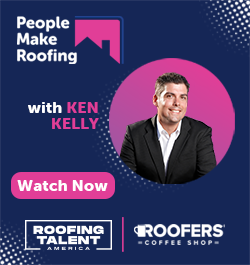



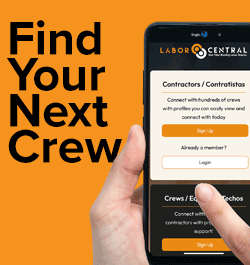








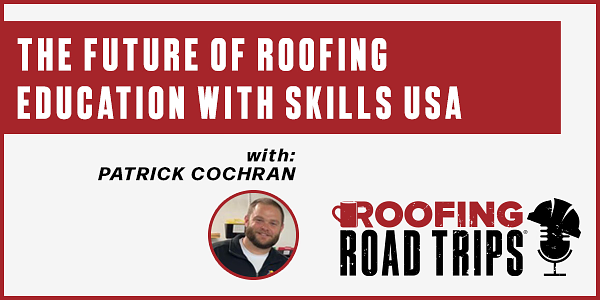
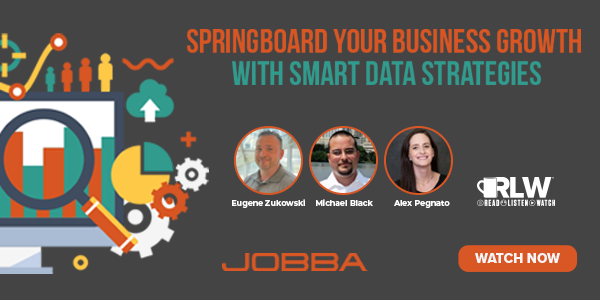






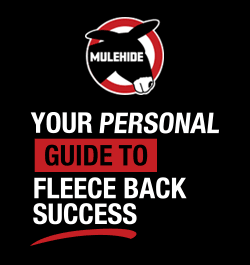

Comments
Leave a Reply
Have an account? Login to leave a comment!
Sign In